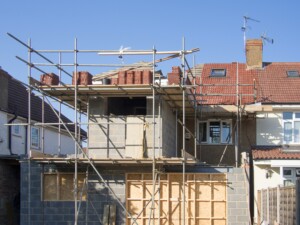Modernist architects who want to design buildings for the federal government may have dodged a bullet when Joe Biden was declared the winner over Donald Trump in the 2020 Presidential Election over the weekend.
President Trump floated the idea of passing an executive order in February of this year that would have mandated all new buildings constructed by the federal government be neoclassical, with columns, pediments, and other historicist drag the U.S. government’s preferred style and would have discouraged buildings designed in a modernist or contemporary vein. But the order was never officially signed as Trump moved into campaign mode, which means the U. S. General Services Administration (GSA) hasn’t wholly replaced its longstanding Design Excellence Program. That program invites a wide range of design approaches into the fold, although a recent GSA procurement listing mandated that a new federal district courthouse in Jacksonville, Florida, be designed in the neoclassical style drew scrutiny from the AIA.
Trump’s draft order, entitled Making Federal Buildings Beautiful Again, still could be put into effect while he’s in office. But for architects wondering if they might need to brush up their ABCs (architraves, buttresses, and cornices), there’s a good chance that it won’t be, and that a President-elect Biden won’t see the need for it. Even though he owns fairly traditional homes in Greenville, Delaware, and Rehoboth Beach, Delaware, Biden never once campaigned on a platform of making classicism the default architectural style of the federal government, nor mentioned it on his campaign site.
Biden has reportedly always been interested in buildings, though. He bought the former DuPont mansion in Delaware shortly after his first wife and daughter were killed in a car accident in 1972, and he rented Alexander Haig’s sprawling Georgian-style estate in McLean, Virginia, as his D. C. base after his term as vice president ended in 2017. Biden has indicated that if he hadn’t gone into public service, he might have become an architect. “Even as a kid in high school I’d been seduced by real estate,” he confessed in his 2007 autobiography, Promises to Keep.
As President, Biden will have a chance to rethink many other real estate- and architecture-oriented decisions that Trump has weighed in on but never resolved. It all depends, of course, on how soon the GSA frees up the money needed for a transition to begin.
The list includes:
Selecting a site for a new FBI headquarters: The GSA was about to select land either in Virginia or Maryland to build a new FBI headquarters when Trump became president and put a halt to the planning. He said he wanted the FBI to stay where it is in the District of Columbia, even if the staff had to move out temporarily while the building undergoes renovation. The FBI headquarters at 935 Pennsylvania Avenue is almost directly across the street from the Trump International Hotel at 1100 Pennsylvania Avenue, and there has been speculation that Trump didn’t want to do anything that might allow it to become the site of a competing hotel.
National Garden of American Heroes: After Confederate statues and other monuments were toppled or damaged this summer as part of the protests following the deaths of George Floyd and Breonna Taylor, Trump proposed the creation of a National Garden of American Heroes, a statuary park featuring the likenesses of everyone from Billy Graham to Booker T. Washington. The goal was to have it in place in time for the nation’s 250th anniversary in 2026, but a site hasn’t been selected yet.
The U.S.-Mexico border wall: One of Trump’s first initiatives was to build a wall along the U. S.-Mexico border to prevent illegal crossings. Various prototypes were designed and tested, but not many miles of new wall were ultimately completed. It will be up to the next administration to decide how to proceed.
Fencing around the White House: After extensive review and debate during the waning months of the Obama administration, the National Capital Planning Commission and others approved plans for a 14-foot-high security fence to replace the 7-foot-tallfence around the White House and other federal buildings. In the wake of last summer’s peaceful demonstrations, the Trump administration erected “temporary” fences that no review panel ever approved, and much of it makes it hard to see the landmarks they surround. How long will they stay up if the Biden administration defers review authority to the appropriate design panels?
Federal boards and commissions: Speaking of design review, the new administration has the authority to appoint members to federal design- and construction-related panels, including the National Capital Planning Commission and the U. S. Fine Arts Commission, as well as agencies that oversee historic buildings; new construction; monuments; embassies and consulates.
Mount Rushmore: Trump has dreamed of having his likeness added to the four Presidents already featured on Mount Rushmore, a national memorial. Some say there isn’t room, but South Dakota Governor Kristi Noem this year presented Trump with a model showing how it could be done, with a 60-foot-tall carving of his face joining George Washington, Thomas Jefferson, Abraham Lincoln, and Theodore Roosevelt.
The Trump Presidential Library: What materials might be in a speculative Trump Presidential Library, and who would be best to design it? Would architects be willing to publicly sign on?
White House Tennis Pavilion and Rose Garden: First Lady Melania Trump received plenty of attention for redesigning the White House Rose Garden and starting construction on a neoclassical Tennis Pavilion (mostly an oversized changing area). The Rose Garden and been put in use, but the Tennis Pavilion hasn’t had its grand opening. Will Biden do the honors?











